Honey

Honey is the sugary substance produced by bees from flower nectar or from honeydew, the material secreted by aphids and some insectsas they feed on plant sap. Honey is 80% fructose, glucose and other sugars. From the Stone Age to the end of the medieval period, it was the most important “concentration of sweetness” known to man.
Until the end of the 1800s, honey was processed using skep-based extraction that required the killing of bees. In the autumn, honey producers purchased hives found in nature from farmers; they then killed the bees with sulfur and removed them from the hives. The honeycomb was crushed, left to drain into containers and rinsed several times. The water collected through this process was sold to prepare Christmas desserts; the honeycomb was boiled and pressed through a wringer. The resulting wax was then melted in hot water, placed into round dishes and left to harden. Wax was sold to a wide range of industries, from producers of cosmetics to furniture polish, from shoemakers to smelters. In the early 1900s, beekeepers began to use modern hives and honey collection no longer required the killing of bees.
This section of the museum tells the story of the Girotti family, Bolognesi beekeepers of the 1800s and 1900s, who founded one of the most advanced beekeeping companies in Italy and were the largest producer of honey in the province of Bologna until the end of the Second World War. The Girotti family story says much about how developments in one agricultural sphere impact another, as increasing access to cheap sugar led to a decrease in the consumption of honey. Europeans first began to use sugar rather than honey in the 1700s, though it was not until later in the 19th and 20th centuries that the impact of this shift was felt in the local market. Honey has since regained popularity, thanks to an increase in attention to wholesome foods and concern for the environment.